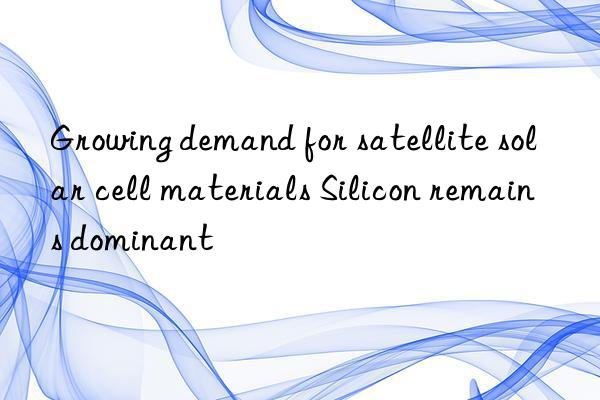
The selection of satellite solar cell materials depends on specific application requirements and environmental conditions, different materials have different advantages and applicability, the main materials are monocrystalline silicon, polycrystalline silicon and gallium nitride, ultra-thin gallium arsenide is also used in the manufacture of solar panels, this material has excellent resistance to radiation, which helps to improve the performance of the satellite. The ” Global and Chinese Satellite Solar Cell Material Industry In-depth Research Report 2024 ” issued by Xinsiye Industry Research Centre shows that the global satellite solar cell material market size may grow from USD 0.45 billion in 2024 to USD 102 million by 2028, at a CAGR of 17.8%.
Currently, the most commonly used in the market are monocrystalline and polycrystalline silicon, with silicon remaining the industry leader due to its low cost and known technology, but advances in the development of materials such as gallium arsenide and germanium multi-junction cells have also led to the promise of improved efficiency and radiation resistance for these materials.
By satellite orbit, polar orbit satellites have the largest share of demand for satellite solar cell materials
Divided by satellite orbit, polar orbit satellites have the largest proportion of demand for solar battery materials. Firstly, polar orbit satellites require global coverage for applications such as Earth observation, environmental monitoring and reconnaissance that require extensive space data collection. Polar orbits provide unique orbital characteristics that enable satellites to reach almost every point on the Earth’s surface, resulting in a wide range of applications. In addition, polar-orbiting satellites are often deployed for scientific research missions, space exploration and transnational cooperation, thus requiring the use of reliable and efficient solar cells to power these projects.
In addition, advances in satellite technology have pushed satellites to become smaller and more capable, increasing the need for solar cells optimised for compact spacecraft designs, which are also ideal for polar-orbiting satellite deployments. The increasing commercialisation of space operations and the emergence of new applications such as satellite-based Internet services and global connectivity solutions are helping to increase the market share of polar-orbiting satellites in the satellite solar cell materials market. Overall, the combination of extensive global coverage, various applications, technological advancements, and emerging market prospects is driving the growth in demand for solar cell materials for polar orbiting satellites.
Silicon materials to remain the largest segment by material type
The silicon materials segment is widely used in the satellite solar cell materials market as there are a number of key aspects that underpin its dominance. Firstly, silicon-based solar cells have a long history of durability and performance in space, making them an excellent choice for satellite applications. Silicon solar cells have extremely high efficiency, excellent radiation resistance, and good durability, all of which allow silicon to be used in harsh space environments for long-term missions. In addition, global silicon resources are plentiful and manufacturing methods have been proven to enable economies of scale and cost-effective manufacturing.
In addition, the continued development of silicon solar cell technology has improved its efficiency and reliability, solidifying its position as the material of choice for satellite power generation. In addition, silicon is compatible with existing satellite designs and equipment, ensuring seamless integration and lower deployment costs, making it a practical choice for satellite manufacturers. Good adaptability is another reason why silicon occupies an important position in the satellite solar cell material market, with solar cells made of silicon able to meet specific performance requirements and adapt to changing mission needs. While other materials, such as gallium arsenide (GaAs), offer higher efficiencies, silicon’s balance of performance, reliability and cost-effectiveness makes it the most popular material type for a variety of satellite applications. Overall, the combination of reliability, performance, scalability, and versatility has made the silicon materials segment the largest and most dominant segment of the satellite solar cell materials market, serving as the foundation for solar power generation from satellites in orbit.
Currently, the key players in the global satellite solar cell materials market include SPECTROLAB (U.S.), AZUR SPACE Solar Power GmbH (Germany), ROCKET LAB USA (U.S.), Sharp Corporation (Japan), CESI SpA (Italy), Thales Alenia Space (France), AIRBUS (France), MicroLink Devices, Inc. (USA), Mitsubishi Electric Corporation (Japan), Northrop Grumman Corporation (USA), etc.
Polyurethane sealer BA100 – morpholine
Polycat 77 catalyst CAS3855-32-1 Evonik Germany – morpholine
Dabco 1027 Catalyst CAS100515-55-5 Evonik Germany.pdf – morpholine
Polycat 41 catalyst CAS10294-43-5 Evonik Germany.pdf – morpholine

 微信扫一扫打赏
微信扫一扫打赏

